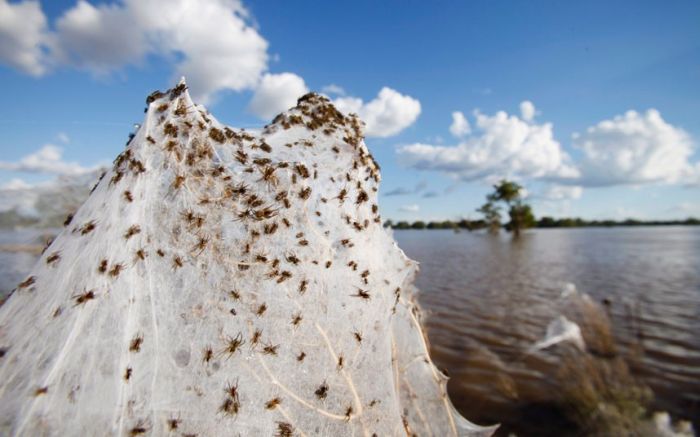|
|
Spider Invasion, Australia
|
Only three classes of pigment (ommochromes, bilins and guanine) have been identified in spiders, although other pigments have been detected but not yet characterized. Melanins, carotenoids and pterins, very common in other animals, are apparently absent. In some species the exocuticle of the legs and prosoma is modified by a tanning process, resulting in brown coloration. Bilins are found, for example, in Micrommata virescens, resulting in its green color. Guanine is responsible for the white markings of the European garden spider Araneus diadematus. It is in many species accumulated in specialized cells called guanocytes. In genera such as Tetragnatha, Leucauge, Argyrodes or Theridiosoma, guanine creates their silvery appearance. While guanine is originally an end-product of protein metabolism, its excretion can be blocked in spiders, leading to an increase in its storage. Structural colors occur in some species, which are the result of the diffraction, scattering or interference of light, for example by modified setae or scales. The white prosoma of Argiope results from hairs reflecting the light, Lycosa and Josa both have areas of modified cuticle that act as light reflectors.
Web types
There is no consistent relationship between the classification of spiders and the types of web they build: species in the same genera may build very similar or significantly different webs. Nor is there much correspondence between spiders' classification and the chemical composition of their silks. Convergent evolution in web construction, in other words use of similar techniques by remotely related species, is "rampant". Non-orb web designs and the spinning behaviors that produce them have received very little attention from arachnologists, despite the fact that the majority of spiders build non-orb webs. The basic radial-then-spiral sequence visible in orb webs and the "sense of direction" required to build them may have been inherited from the common ancestors of most spider groups. It used to be thought that the sticky orb web was an evolutionary innovation resulting in the diversification of the Orbiculariae. Now, however, it appears that non-orb spiders are a sub-group that evolved from orb-web spiders, and non-orb spiders have over 40% more species and are four times as abundant as orb-web spiders. Their greater success may be because sphecid wasps, which are often the dominant predators on spiders, much prefer to attack spiders that have flat webs.
|
|









